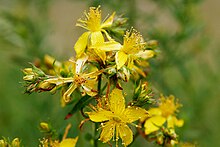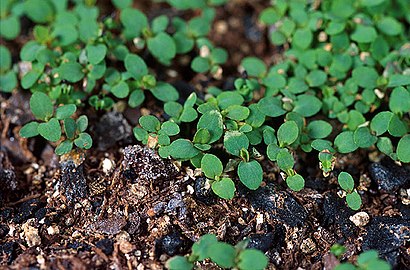
A | B | C | D | E | F | G | H | CH | I | J | K | L | M | N | O | P | Q | R | S | T | U | V | W | X | Y | Z | 0 | 1 | 2 | 3 | 4 | 5 | 6 | 7 | 8 | 9
| Hypericum perforatum | |
|---|---|

| |
| Scientific classification | |
| Kingdom: | Plantae |
| Clade: | Tracheophytes |
| Clade: | Angiosperms |
| Clade: | Eudicots |
| Clade: | Rosids |
| Order: | Malpighiales |
| Family: | Hypericaceae |
| Genus: | Hypericum |
| Section: | Hypericum sect. Hypericum |
| Species: | H. perforatum
|
| Binomial name | |
| Hypericum perforatum | |
| Subspecies | |
| |
| Synonyms | |
| |
Hypericum perforatum, commonly known as St John's wort, is a flowering plant in the family Hypericaceae. It is a perennial plant that grows up to one meter tall, with many yellow flowers that have clearly visible black glands around their edges, long stamens (male reproductive organs), and three pistils (female reproductive organs). Probably a hybrid between the closely related H. attenuatum and H. maculatum that originated in Siberia, the species is now found worldwide. It is native to temperate regions across Eurasia and North Africa, and has been introduced to East Asia, Australia, New Zealand, and parts of North and South America. In many areas where it is not native, H. perforatum is considered a noxious weed. It densely covers open areas to the exclusion of native plants, and is poor grazing material. As such, methods for biocontrol have been introduced in an attempt to slow or reverse the spread of the species.
The species produces numerous chemical compounds that are highly active. These chemicals are harmful to large animals, especially sheep, and help to deter herbivores from consuming the plant. Other chemicals in the plant, such as hypericin and hyperforin, have various uses in medicine. St John's wort has been used in traditional medicine since at least the first century AD, often as a cure-all or panacea. The oil from its glands can be extracted, or its above-ground parts can be ground into a powder called herba hyperici. In modern times, its use as an antidepressant has been the focus of numerous studies and clinical trials; however, the active ingredients can be very harmful or even lethal when taken alongside other medicines.
Description
Hypericum perforatum is an herbaceous perennial plant with hairless (glabrous) stems and leaves.[1] The root of each plant is slender and woody with many small, fibrous small side roots and also extensive, creeping rhizomes.[2] The central root grows to a depth of 0.6–1.5 meters into the soil depending on conditions.[3] The crown of the root is woody.[2]

Its stems are erect and branched in the upper section, and usually range from 0.3 metres to 1 metre in height.[3] The stems are woody near their base and look like they have segmented joints from the scars left behind after the leaves fall off.[4] The stems of H. perforatum are rusty-yellow to rosy in color with two distinct edges and usually have bark that sheds near the base. The stems persist through the winter and sprout new growth with flower buds in the following year; first year growth does not produce flowers.[2]

It has leaves that attach on opposite sides of the stems without a stalk (sessile). The leaves vary in shape from being very narrow and almost grass-like (linear), to a rounded oval slightly wider at the base with a rounded tip or not much of a tip (elliptic), or even narrow with the widest portion towards the end of the leaf like a reversed lance point, but still long and narrow (oblanceolate).[2] The principle leaves range in length from 0.8 to 3.5 centimetres[1] and 0.31–1.6 centimetres in width.[2] Leaves borne on the branches subtend the shortened branchlets. The leaves are yellow-green in color, with scattered translucent dots of glandular tissue.[5][6] The dots are clearly visible when held up to the light, giving the leaves a perforated appearance.[7] The edges (margins) of the leaves usually have scattered black dots, often called dark glands, though sometimes they will appear away from the edges.[2][8] The odor of the plant is faint, but aromatic, resembling that of resins like balsam. The taste of the plant is bitter and acrid.[1]
Flowering characteristics

The flowers are conspicuous and showy, measuring about 1.5–2.5 cm across, and are bright yellow with black dots along the edges of the petals.[9][2][10] Each of the flowers normally has five large petals and five smaller leaf-like sepals below them. The sepals are about 4–5 mm in length, green in color, are shaped like the head of a spear (lanceolate shape) with a pointed tip, and the same clear and black glands as the leaves. The petals are significantly longer, 8–12 mm in length, and have an oblong shape. They completely hide the sepals from the front side of the flower.[11] The many bright yellow stamens are united at the base into three bundles.[11] The stalk portion of the stamens, the filaments, vary in length and stick out in every direction from the center of the flower.[2] The pollen grains are pale brown to orange in color.[12]
The flowers are arranged along one side of each flowering stem with two flowers at each node (a helicoid cyme) at the ends of the upper branches, between late spring and early to mid-summer.[13] Each flowering stem bears many flowers, between 25 and 100, and also is quite leafy.[11]
The fruit of Hypericum perforatum is a capsule 7–8 mm in length containing the seeds in three valved chambers.[11][2] Seeds that are separated from the capsules have a much higher germination rate due to an inhibiting factor in the capsule itself.[3] The black and lustrous seeds are rough, netted with coarse grooves.[14] Each seed is about 1 millimeter in size.[11] Each plant may produce an average of 15,000 to 34,000 seeds.[3]
Similar species
Hypericum maculatum is visually similar to Hypericum perforatum; however, its stems have four ridges instead of two and are also hollow. In addition, its leaves have fewer translucent glands and more dark glands. H. maculatum is native to the Old World but has also been introduced to North America.[3]
In North America several native species may be confused with Hypericum perforatum. Hypericum anagalloides is a low-growing creeping plant with rounder leaves and fewer stamens. Hypericum boreale is a smaller plant with more delicate flowers. Hypericum canadense has smaller flowers with sepals that show between the petals. Hypericum concinnum has flowers with petals that bend backward at the tip and also has much narrower, gray-green leaves. Growing in riparian areas along rivers, Hypericum ellipticum has wider leaves with a more elliptic shape. Hypericum scouleri has leaves that are broader at the base and also thicker. All except for H. concinnum grow in environments that are generally more moist than where H. perforatum is found.[3]
Phytochemistry

The most common active chemicals in Hypericum perforatum are hypericin and pseudohypericin (naphthodianthrones), and hyperforin (a phloroglucinol derivative).[13][15][16] It also contains a host of essential oils, the bulk of which are sesquiterpenes.[13] In the wild, the concentrations of any active chemicals can vary widely among individual plants and populations.[17]
| Compound | Conc.[18] [20] |
log P | PSA | pKa | Formula | MW | CYP1A2 [Note 1] |
CYP2C9 [Note 2] |
CYP2D6 [Note 2] |
CYP3A4 [Note 2] |
PGP [Note 2] |
t1/2[20] (h) | Tmax[20] (h) | Cmax[20] (mM) | CSS[20] (mM) | Notes/Biological activity[Note 3] |
|---|---|---|---|---|---|---|---|---|---|---|---|---|---|---|---|---|
| Phloroglucinols (2–5%) | ||||||||||||||||
| Adhyperforin | 0.2–1.9 | 10–13 | 71.4 | 8.51 | C36H54O4 | 550.81 | ? | ? | ? | ? | ? | ? | ? | ? | ? | ? |
| Hyperforin | 2–4.5 | 9.7–13 | 71.4 | 8.51 | C35H52O4 | 536.78 | + | +/- | – | + | + | 3.5–16 | 2.5–4.4 | 15-235 | 53.7 | – |
| Naphthodianthrones (0.03-3%) | ||||||||||||||||
| Hypericin | 0.003-3 | 7.5–10 | 156 | 6.9±0.2 | C30H16O8 | 504.44 | 0 | – (3.4 μM) |
– (8.5 μM) | – (8.7 μM) |
? | 2.5–6.5 | 6–48 | 0.66-46 | ? | ? |
| Pseudohypericin | 0.2–0.23 | 6.7±1.8 | 176 | 7.16 | C30H16O9 | 520.44 | ? | ? | ? | ? | ? | 24.8–25.4 | 3 | 1.4–16 | 0.6–10.8 | – |
| Flavonoids (2–12%) | ||||||||||||||||
| Amentoflavone |
0.01–0.05 | 3.1–5.1 | 174 | 2.39 | C30H18O10 | 538.46 | ? | – (35 nM) |
– (24.3 μM) | – (4.8 μM) |
? | ? | ? | ? | ? | ? |
| Apigenin | 0.1–0.5 | 2.1±0.56 | 87 | 6.63 | C15H10O5 | 270.24 | ? | ? | ? | ? | ? | ? | ? | ? | ? | ? |
| Catechin | 2–4 | 1.8±0.85 | 110 | 8.92 | C15H14O6 | 290.27 | ? | ? | ? | ? | ? | ? | ? | ? | ? | ? |
| Epigallocatechin | ? | −0.5–1.5 | 131 | 8.67 | C15H14O6 | 290.27 | ? | ? | ? | ? | ? | 1.7±0.4a | 1.3–1.6a | ? | ? | ? |
| Hyperoside | 0.5-2 | 1.5±1.7 | 174 | 6.17 | C21H20O12 | 464.38 | ? | ? | ? | ? | ? | ? | ? | ? | ? | |
| Kaempferol | ? | 2.1±0.6 | 107 | 6.44 | C15H10O6 | 286.24 | ? | ? | ? | +/- | ? | ? | ? | ? | ? | ? |
| Luteolin | ? | 2.4±0.65 | 107 | 6.3 | C15H10O6 | 286.24 | – | ? | ? | ? | ? | ? | ? | ? | ? | ? |
| Quercetin | 2–4 | 2.2±1.5 | 127 | 6.44 | C15H10O7 | 302.24 | – (7.5 μM) b |
– (47 μM) b |
– (24 μM) b |
– (22 μM) b |
– | 20–72c | 8c | ? | ? | ? |
| Rutin | 0.3–1.6 | 1.2±2.1 | 266 | 6.43 | C27H30O16 | 610.52 | ? | ? | ? | ? | ? | ? | ? | ? | ? | ? |
| Phenolic acids (~0.1%) | ||||||||||||||||
| Caffeic acid | 0.1 | 1.4±0.4 | 77.8 | 3.64 | C9H8O4 | 180.16 | ? | ? | ? | – | ? | ? | ? | ? | ? | ? |
| Chlorogenic acid | <0.1% | -0.36±0.43 | 165 | 3.33 | C16H18O9 | 354.31 | 0 | 0 | 0 | 0 | ? | ? | ? | ? | ? | ? |




